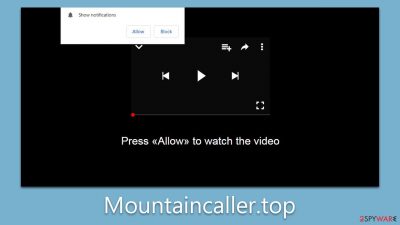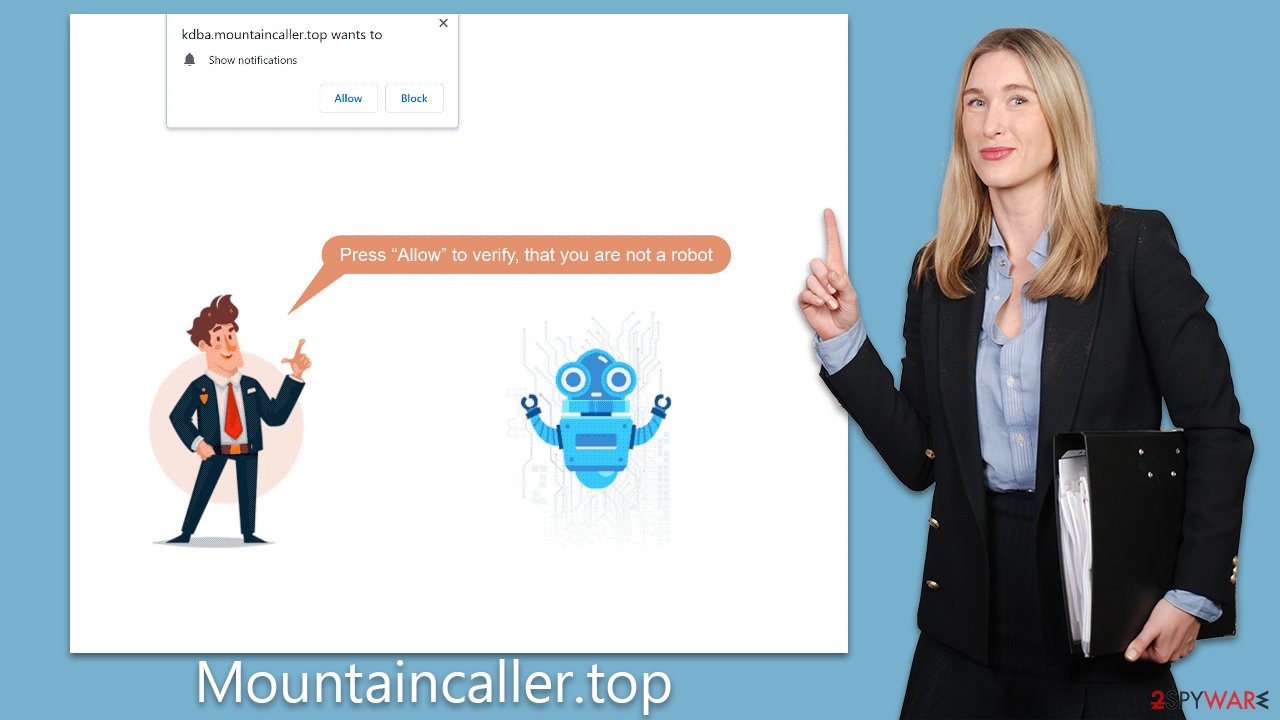Mountaincaller.top ads (fake) - Free Guide
Mountaincaller.top ads Removal Guide
What is Mountaincaller.top ads?
Mountaincaller.top is a fake website created by scammers

Mountaincaller.top is a deceptive website engaging in push notification scams. Deceptively presented as legitimate, this site manipulates unsuspecting users into subscribing to its notifications. Typically, users land on this site through intrusive advertisements or potentially unwanted applications (PUAs). After gaining permission for push notifications, Mountaincaller.top begins bombarding subscribers with misleading messages, including false virus infection alerts, alongside regular advertisements.
This intrusive behavior is not only a nuisance but also a potential risk to users' digital security. Subscribers may be led to believe their device is infected with malware and be tricked into downloading more harmful applications or adware. Unwanted ads may also flood their screens, disrupting normal browsing activities. If you are grappling with these unwelcome notifications and suspect your device may be compromised, the upcoming sections of this article will provide critical guidance on how to eliminate these issues and protect your device against potential threats.
| Name | Mountaincaller.top |
| Type | Push notifications, ads, pop-ups, scam |
| Distribution | Users allow push notifications after they click the “Allow” button within the prompt |
| Symptoms | You may start seeing intrusive pop-ups on your desktop – clicking these may lead to insecure or even malicious websites |
| Risks | If you click on links provided by the website, you might end up infecting your system with malware/PUPs, disclosing your personal information to cybercriminals, or losing money for useless services |
| Removal | To block the intrusive pop-ups, you need to access your browser's settings section. Also, perform a scan with SpyHunter 5Combo Cleaner anti-virus to check for infections |
| Other tips | You should check your system with FortectIntego to fix virus damage and remove various trackers from your browsers |
How unsuspecting users fall victims of push notification scams
A push notification scam is a deceptive technique often utilized by questionable websites like Mountaincaller.top, aiming to trick users into subscribing to their push notifications. The scam operates by presenting users with seemingly innocuous or attractive prompts strategically designed to induce a user interaction.
Mountaincaller.top, for instance, employs a variety of such manipulative messages. A user may be asked to confirm they are above the age of 18 by clicking “Allow.” Some might see a tempting lure of a prize, with instructions to click “Allow” to win it and retrieve it from their shop. Other instances include claims of starting a download or verifying the user is not a robot, both necessitating a click on the “Allow” button.
Among the most deceptive tactics is preying on a user's desire to access specific content. For example, a prompt may suggest that a video can't be played due to browser restrictions and that the user should click “Allow” to watch the video. This particular strategy plays on the user's immediate interest, making it a powerful tool in the scammer's arsenal.
The purpose of these misleading prompts is singular: to secure the user's permission to send push notifications. However, once granted, these permissions are abused. Instead of the anticipated content, users receive an onslaught of intrusive advertisements and misleading alerts, such as false virus infection warnings.

How to recognize and avoid online fraud
Falling prey to push notification scams like those orchestrated by Mountaincaller.top can have far-reaching implications. Beyond the annoyance of constant, intrusive advertisements, these scams can redirect users to other fraudulent websites or even expose them to inappropriate content. Further, they can trick users into downloading malware or potentially unwanted applications, resulting in a compromised system and degraded device performance.
In more severe cases, these scams can severely jeopardize digital security. Crafted phishing links or deceptive software could capture sensitive personal data, including login details and financial information. This exposure can lead to devastating outcomes, such as identity theft or unauthorized transactions.
With these potential threats in mind, it's crucial to recognize the signs of a push notification scam. One clear indication is a flood of pop-ups or persistent requests to enable notifications, often expressed with urgency. Also, be wary of websites that lack a clear purpose beyond encouraging you to allow notifications.
Manipulative and misleading messages are another telltale sign. Websites may promise access to specific content, offer enticing prizes, or purport to require age verification or robot confirmation. These are often bait-and-switch tactics to coax users into subscribing to their push notifications.
Furthermore, some websites employ scare tactics, mimicking legitimate system alerts. For example, they might issue false virus infection warnings to induce fear and manipulate users into downloading harmful software disguised as necessary protection.
To avoid landing on scam websites, it's advised to be cautious about the sites you visit and the links you click, especially those received via emails, messages, or social media. Ensure your device has reliable security software installed and regularly updated. Avoid downloading apps or software from untrusted sources. By recognizing these signs and practicing good digital hygiene, you can protect yourself from push notification scams and safeguard your online experience.
Check your system for infections and remove unwanted push notifications
While an influx of push notifications from sites like Mountaincaller.top is a nuisance, it's crucial to understand that it does not directly imply a system infection. However, the presence of adware or other malicious applications can't be ruled out entirely. Adware is notorious for redirecting users to malicious websites and inserting harmful links, making a comprehensive system check worthwhile.
Using robust security software such as SpyHunter 5Combo Cleaner or Malwarebytes can effectively identify and remove any potential threats. These tools are adept at scanning your system, detecting and eliminating a wide range of threats, from adware to more severe malware, thus ensuring a secure environment.
Post-removal, it's recommended to clear cookies and other web data to fully eliminate any traces of infection. This is where tools like FortectIntego come in handy. Not only does it assist in cleaning up your digital space, but it can also repair any malware-induced damage, helping to restore your system to its optimal state.
As for unwanted push notifications, their removal involves unsubscribing from them within your browser settings. This process varies slightly between different browsers but generally involves navigating to the site settings and revoking the site's notification permissions.
Please note that the exact steps for this process, tailored to specific browsers, are detailed in the removal guide provided below. By adhering to these instructions, you can effectively rid yourself of unwanted push notifications and regain control over your digital experience.
Always remember that maintaining up-to-date security software, practicing cautious browsing habits, and promptly addressing any signs of infection is key to safeguarding your digital life against potential threats.
Google Chrome (desktop)
- Open the Google Chrome browser and go to Menu > Settings.
- Scroll down and click on Advanced.
- Locate the Privacy and security section and pick Site Settings > Notifications.
- Look at the Allow section and look for a suspicious URL.
- Click the three vertical dots next to it and pick Block. This should remove unwanted notifications from Google Chrome.
![Stop notifications on Chrome PC 2 Stop notifications on Chrome PC 2]()
Google Chrome (Android)
- Open Google Chrome and tap on Settings (three vertical dots).
- Select Notifications.
- Scroll down to the Sites section.
- Locate the unwanted URL and toggle the button to the left (Off setting).
![Stop notifications on Chrome Android Stop notifications on Chrome Android]()
Mozilla Firefox
- Open Mozilla Firefox and go to Menu > Options.
- Click on Privacy & Security section.
- Under Permissions, you should be able to see Notifications. Click the Settings button next to it.
- In the Settings – Notification Permissions window, click on the drop-down menu by the URL in question.
- Select Block and then click on Save Changes. This should remove unwanted notifications from Mozilla Firefox.
![Stop notifications on Mozilla Firefox 2 Stop notifications on Mozilla Firefox 2]()
MS Edge (Chromium)
- Open Microsoft Edge, and go to Settings.
- Select Site permissions.
- Go to Notifications on the right.
- Under Allow, you will find the unwanted entry.
- Click on More actions and select Block.
![Stop notifications on Edge Chromium Stop notifications on Edge Chromium]()
Safari
- Click on Safari > Preferences…
- Go to the Websites tab and, under General, select Notifications.
- Select the web address in question, click the drop-down menu and select Deny.
![Stop notifications on Safari Stop notifications on Safari]()
Internet Explorer
- Open Internet Explorer, and click on the Gear icon at the top-right of the window.
- Select Internet options and go to the Privacy tab.
- In the Pop-up Blocker section, click on Settings.
![Stop notifications on Internet Explorer Stop notifications on Internet Explorer]()
- Locate the web address in question under Allowed sites and pick Remove.
How to prevent from getting adware
Choose a proper web browser and improve your safety with a VPN tool
Online spying has got momentum in recent years and people are getting more and more interested in how to protect their privacy online. One of the basic means to add a layer of security – choose the most private and secure web browser. Although web browsers can't grant full privacy protection and security, some of them are much better at sandboxing, HTTPS upgrading, active content blocking, tracking blocking, phishing protection, and similar privacy-oriented features. However, if you want true anonymity, we suggest you employ a powerful Private Internet Access VPN – it can encrypt all the traffic that comes and goes out of your computer, preventing tracking completely.
Lost your files? Use data recovery software
While some files located on any computer are replaceable or useless, others can be extremely valuable. Family photos, work documents, school projects – these are types of files that we don't want to lose. Unfortunately, there are many ways how unexpected data loss can occur: power cuts, Blue Screen of Death errors, hardware failures, crypto-malware attack, or even accidental deletion.
To ensure that all the files remain intact, you should prepare regular data backups. You can choose cloud-based or physical copies you could restore from later in case of a disaster. If your backups were lost as well or you never bothered to prepare any, Data Recovery Pro can be your only hope to retrieve your invaluable files.






